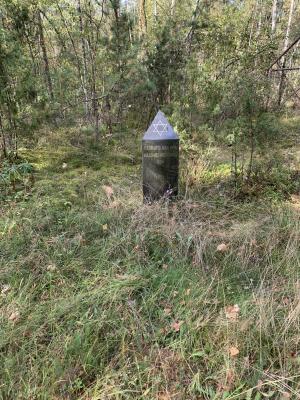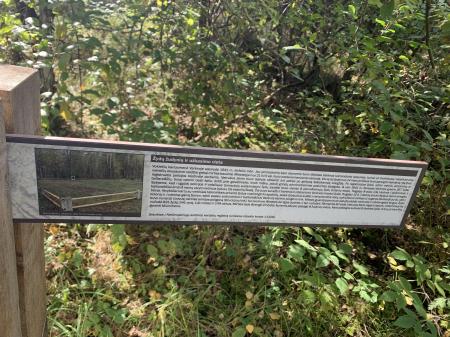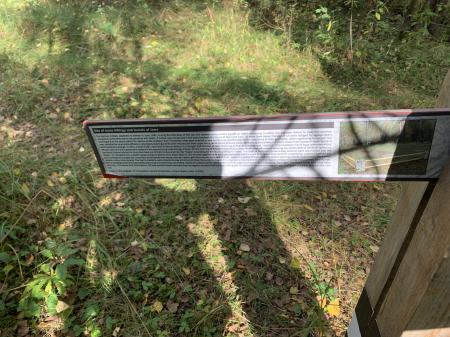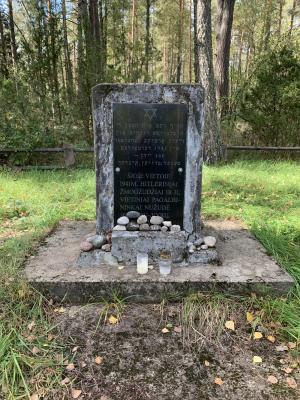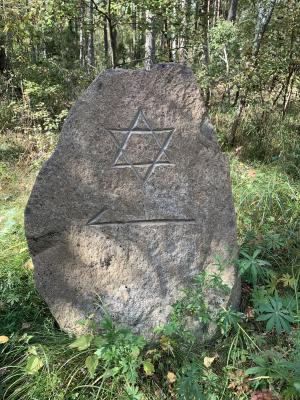Obj. ID: 52868
Jewish Funerary Art Holocaust memorial near Varėna, Lithuaniay, 1990s

Memorial Name
Žydų žudynių ir užkasimo vieta - Mass killing site and burial place of the Jews.
Who is Commemorated?
831 Varėna Jews murdered at this site.
Description:
The monument is situated on the killing site surrounded by concrete posts, with wooden poles connecting it.
The monument is a concrete block with granite plaque attached to it. A Yiddish inscription occupies its central part; beneath it, there is a Lithuanian inscription. A Star of David is depicted in the upper part of the plaque. There is a directional sign on the way to the killing site with information about the Holocaust in Varėna.
Inscription:
Yiddish:
אויף דעם אָרט
האָבן די היטלערישע רוצחים און
זייערע אָרטיגקע באהעלפער
אין 1941 דערמאָרדעט
360 יידן -
מענער, פרויען, קינדער
Translation: At this place, Hitlerite murderers and their local helpers, in 1941, murdered 360 Jews - men, women, children.
Lithuanian:
Šioje vietoje
1941 m. hitleriniai
žmogžudžiai ir jų
vietiniai pagalbi-
ninkai nužudė
360 žydų – vyrų,
moterų, vaikų
Translation: At this place / in 1941 the Hitlerian / murderers and their / local collabo / rators murdered / 360 Jews-men, / women and children
Inscription on the stand:
Lithuanian:
Žydų žudynių ir užkasimo vieta
Vokiečių kariuomenė Varėnoje pasirodė 1941 m. birželio mėn. Jau pirmosiomis karo dienomis buvo išleistas Varėnos komendanto įsakymas, kuriuo už menkiausią nepaklusnumą
vokiečių okupacinei valdžiai grėsė mirties bausmė. Miestelyje nuo 21 iki 5 val. buvo įvesta komendanto valanda. Visi vyrai žydai nuo 14 metų amžiaus buvo įpareigoti kiekvieną ryta 8 val.
registruotis policijos būstinėje darbams. Netrukus buvo jiems įakyta užsisiūti ant peties po geltoną šešiakampę žvaigždę. Po registracijos žydai, lydimi vietinių policininkų ar
baltaraiščių, buvo varomi tiesti kelio, dirbti prie geležinkelio, kirsti miško, plauti grindų administracinės paskirties įstaigose. Iš viso 1941 m. Senojoje Varėnoje gyveno 267 žydai.
Spėjama, kad rugpjūtį policijos ir valsčiaus tarnautojų sudarinėjami žydų sąrašai buvo vienas iš paruošiamųjų žydų žudynių etapų. Rugsėjo 8-osios rytą Varėnos I policininkai ir
baltaraiščiai ėmė iš namų varyti vietinius žydus į čia esančią škalą. Čia buvo suvežti ir Varėnos II (dabartinio Varėnos miesto) žydai. Rugsėjo 10d. į Varėną atvyko Alytaus rajono smogikų
būrys. Atvykėliai kartu su vietiniais talkininkais privertė žydus nusirengti iki apatinių, įsakė drabužius sudėti į vieną bendrą vietą, sukryžiavus rankas už nugaros išsirikiuoti po du, stoti į
koloną ir, nuleidus galvą žemyn, sekti paskui policininkus ir baltaraiščiua Varėnos karinio poligono link. Miesto gyventojams buvo įsakya sedėti namuose ir užsidangstyti langus. Žydai
buvo nuvaryti į buvusį carinės armijos poligoną (Druckūnų link), kur jau buvo iškastos dvi ilgos duobės, ir ten nužudyti. Remiantis SD vado Lietuvoje Karlo Jėgerio raportu, hitlerininkai čia
nužudė 831 žydą: 541 vyrą, 141 moterį ir 149 vaikus. Mirties tada išvengė 23 žydai, kuriems pavyko pabėgti iš žudynių vietos. Karo pabaigos sulaukė 8 Varėnos žydai, 5 iš jų po karo liko
gyventi Miunchene.
Įtrauktas į Nekilnojamų kultūros vertybių registrą (unikalus objekto kodas 11328).
English:
Site of mass killings and burials of Jews
The German military appeared in Varėna in June 1941.during the first days of the war, the Varėna commandant issued an order, according to which the slightest failure to obey the German
occupation authorities was to be punished with death. A curfew was introduced in the town between the hours 9 pm and 5 am. All male Jews above the age of 14 were obliged to register every
morning at 8 at the police station for various kinds of labour. Soon thereafter, they were ordered to sew a yellow six-pointed star on the shoulders of their garments. After registering for labour, the
Jews, escorted by local police officers or volunteers wearing a white cloth tied around their upper arms, were forced to build roads, work along the railway, cut down trees in the forest or wash floors in
administrative buildings. In 1941, a total of 267 Jews lived in Senoji Varėna. It is thought that the lists of Jews drawn up in August by police and „valsčius“ (the smallest unit of local administration)
officials were one of the preparatory steps for the approaching mass killings of Jews. On the morning of 8 September, local police officers and volunteers wearing the white cloth of Varėna I (present-
day Senoji Varėna) started to drive local Jews out of their homes and into the „škala“ (a building for the study of religious texts). The Jews of Varėna II (present-day Varėna) were also forced into the
„škala“. On 10 September, a death squad arrived in Varėna from Alytus District. The arrivals together with local volunteers forced the Jews to undress down to their underwear, ordered them to put
their clothing into a single pile, cross their arm behind their backs, line up in pairs, get into a column and, heads down, follow the police officers and volunteers wearing a white cloth toward the former
Varėna military training area. The town‘s residents were ordered to stay at home and draw the curtains closed. The Jews were marched to the former tsarist military training area (toward Druckūnai),
where two long trench-pits had already been dug, and there they were killed. Based on a report by the commander of SD Einsatzkommando 3a in Lithuania Karl Jager, the Nazis killed 831 Jews here:
541 men, 141 women and 149 children. 23 Jews avoided death because they managed to escape from the mass killing. 8 Jews from Varėna survived the war, 5 of them stayed in Munich after the
war.
Listed in the Register of Immovable Cultural Properties (unique object code 11328).
Commissioned by
The Lithuanian Jewish Community
sub-set tree:
During the first days of September of 1941, local policemen and white armbanders forced the Jews of Varėna into the small town’s synagogue. They were held there for several days. On September 10, 1941, the Chief of the security police of the Alytus region and 30–40 troops arrived in Varėna. They forced Jews to undress to their underwear and marched them onto a former Tsarist military reservation and shot them there.
The Jäger Report indicates that a total of 831 Jews were murdered, including 541 men, 141 women, and 149 children.
A monument was probably erected in the early 1990s.
On March 3, 1993, the monument was registered in the State Cultural Register of the Republic of Lithuania of national importance (no. 11328).
Jakulytė-Vasil, Milda. Lithuanian Holocaust Atlas (Vilnius: VIlna Gaon State Jewish Museum, 2011), p. 26.
Kultūros vertybių registras, https://kvr.kpd.lt/#/heritage-detail/22406dea-20e5-43fe-81f8-748ead67d13a., https://kvr.kpd.lt/#/ (accessed April 24, 2022)
Arūnas Bubnys, Holokaustas Lietuvos provincijoje 1941 metais.




